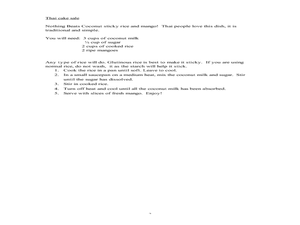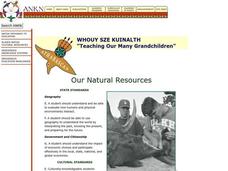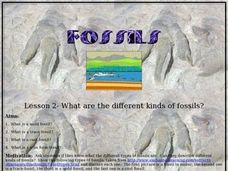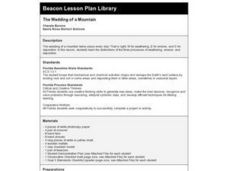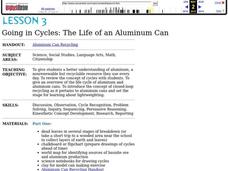Curated OER
Katrina Case Study
Students explore the impact natural events have on the environment, specifically the wetlands. They view a video about the impact of Hurricane Katrina on the Mississippi Delta and answer discussion questions.
Curated OER
Visual Arts: Art in Public Places
Young scholars create 3 dimensional art. In this sculpture lesson, students collect objects that represent their community's values to include in a 3 dimensional sculpture. Young scholars write a paragraph explaining the chosen theme of...
Curated OER
A Bug's Journey
Students research the art of John Baldessari. In this art history lesson, students examine Baldessari's drawing of a beetle and discuss the characteristics of these bugs. They write a story from a bug's perspective and create their own...
Curated OER
Sense of Place: No River Too Wide-Bridges
Fifth graders discover the history of their hometown Des Moines River. In this U.S. Geography lesson students speak with Iowans that tell stories of the settlers and early villages near the Des Moines River. Students document...
Curated OER
Families Around the World
Students discover the similarities and differences in families from around the world. In this multicultural activity, students create their own family album and label each family member. There are suggested activities such as...
Curated OER
Have a Thai day!
Students participate in a fund raiser for the Thai Children's trust. In this sociology lesson plan, students prepare for a Thai Day by making puppets, having a cake sale, making fans, and performing Thai dances.
Curated OER
Plates Everybody Can Make
Students create hand-built plates. In this sculpting lesson, students use textured slab molds and plate drape molds to create a plate. Students use texture tools and paint to design their plate.
Curated OER
The Adoration of Shepherds
Students create bas-relief sculptures of themselves after studying the principles of bas-relief sculpture.
Curated OER
Our Natural Resources
Young scholars discuss key terms used to describe ecosystems and how humans are altering natural resources. They listen to the book, Grandfather's Wisdom, and list the renewable and nonrenewable resources they have used or consumed in...
Curated OER
What are the Different Kinds of Fossils?
Students examine different types of fossils. In this fossil lesson plan, students investigate the attributes of mold fossils, trace fossils, cast fossils, and true form fossils. Students create their own fossil samples.
Curated OER
Remembering the Respiratory System
Sixth graders analyze the components of the respiratory system. In this respiratory system instructional activity, 6th graders participate in hands on experiments and activities to identify the functions of the major organs of the...
Curated OER
I can do it blindfolded!
One method of creating a genuine information gap is through the use of blindfold activities. Blindfolds can be employed in a variety of ways in the TEFL/ESL foster a truly communicative and student-centered approach to learning.
Curated OER
Introduction to Topographic Maps
Tenth graders create a topographic map and see how it represents different elevations. In this topographic maps lesson students read and interpret topographic maps.
Curated OER
The Wedding of a Mountain
Pupils examine the differences between weathering, erosion, and deposition as it pertains to mountains.
Curated OER
Going in Cycles: The Life of an Aluminum Can
Students investigate the manufacture of aluminum cans and consider the energy and resources saved when the cans are made from recycled material. They explore the concept of closed-loop recycling using charts, worksheets and discussion.
Curated OER
Portrait and Figure Drawing
Students investigate the self-portraits and figure drawings of famous artists such as Käthe Kollowitz, Pablo Picasso, Rembrandt and others following their own attempts to create their expressive original drawings.
Curated OER
Oceanography (Rivers and Streams)
Second graders examine the characteristics of streams and rivers. They identify the types of resources lakes, ponds and oceans provide. They ask questions to complete the lesson.
Curated OER
Judaism-Hanukkah: How to Make a Dreidel
In this how-to worksheet, students create their own dreidels by following the six steps provided on this instructional worksheet.
Curated OER
The Magnificent Breathing Machine
Students discover their magnificent breathing machine. In this science lesson plan, students learn the functions of the lungs in our bodies and become aware that in breathing an exchange of gases takes place in the lungs.
Curated OER
It's So Simple
Students use basic materials to create four simple machines. In this introduction to simple machines lesson, students are given four different scenarios that require a simple machine in order to solve. The students use devices such as a...
Curated OER
Making An Anemometer
Young scholars discover how to capture the speed of wind. In this science activity lesson, students gather materials and follow procedures to create an anemometer to measure wind speed.
Curated OER
Going in Cycles: The Life of an Aluminum Can
Students explore the life cycle of aluminum cans. In this recycling lesson, students review the manufacturing process and how to make a closed loop cycle. Students also have the opportunity to present what they've learned to others...
Curated OER
Groundwater as Part of the Water Cycle
Ninth graders study the effects of soil and rocks on filtering groundwater. In this groundwater lesson students complete a lab activity that includes sources of contamination.
Curated OER
Capturing the Moment in 3-D
Students analyze the sculpture "Rearing Horse" by Adriaen de Vries. In this visual arts instructional activity, students examine the sculpture and then draw and sculpt animals from life, trying to capture a moment frozen in time.
Other popular searches
- Clay Modeling Sea Stars
- Clay Modeling Sculpture
- Clay Modeling Planets
- Clay Modeling Horses
- Clay Modeling Communities
- Clay Modeling Pigs
- Clay Modeling and Bartholdi







